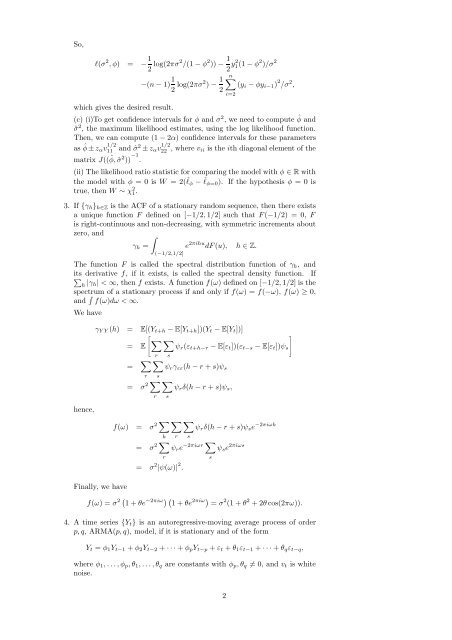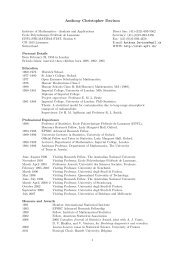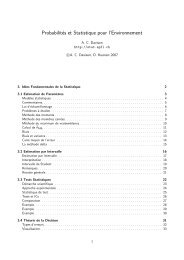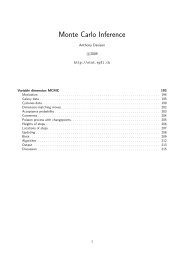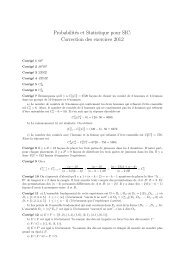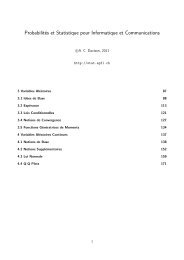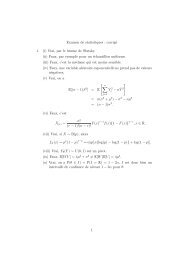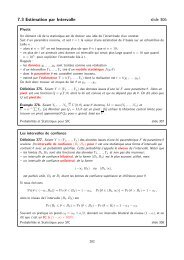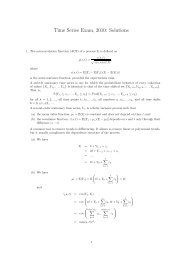So,l(σ 2 ,φ) = − 1 2 log(2πσ2 /(1−φ 2 ))− 1 2 y2 1(1−φ 2 )/σ 2which gives the desired result.−(n−1) 1 2 log(2πσ2 )− 1 2n∑(y i −φy i−1 ) 2 /σ 2 ,(c) (i)To get confidence intervals for φ and σ 2 , we need to compute ˆφ andˆσ 2 , the maximum likelihood estimates, using the log likelihood function.Then, we can compute (1−2α) confidence intervals for these parametersas ˆφ±z α v 1/211 and ˆσ2 ±z α v 1/222 , where v ii is the ith diagonal element of thematrix J((ˆφ,ˆσ 2 )) −1 .(ii) The likelihood ratio statistic for comparing the model with φ ∈ R withthe model with φ = 0 is W = 2(ˆl φ − ˆl φ=0 ). If the hypothesis φ = 0 istrue, then W ∼ χ 2 1 .3. If {γ h } h∈Z is the ACF of a stationary random sequence, then there existsa unique function F defined on [−1/2,1/2] such that F(−1/2) = 0, Fis right-continuous and non-decreasing, with symmetric increments aboutzero, and ∫γ h = e 2πihu dF(u), h ∈ Z.(−1/2,1/2]The function F is called the spectral distribution function of γ h , andits derivative f, if it exists, is called the spectral density function. If∑h |γ h| < ∞, then f exists. A function f(ω) defined on [−1/2,1/2] is thespectrum of a stationary process if and only if f(ω) = f(−ω), f(ω) ≥ 0,and ∫ f(ω)dω < ∞.We haveγ YY (h) = E[(Y t+h −E[Y t+h ])(Y t −E[Y t ])]ñ ô∑ ∑= E ψ r (ε t+h−r −E[ε t ])(ε t−s −E[ε t ])ψ sr s= ∑ ∑ψ r γ εε (h−r +s)ψ sr s= σ 2∑ ∑ψ r δ(h−r+s)ψ s ,r si=2hence,f(ω) = σ 2∑ h= σ 2∑ r∑∑ψ r δ(h−r+s)ψ s e −2πiωhr sψ r e −2πiωr∑ ψ s e 2πiωss= σ 2 |ψ(ω)| 2 .Finally, we havef(ω) = σ 2( 1+θe −2πiω)( 1+θe 2πiω) = σ 2 (1+θ 2 +2θcos(2πω)).4. A time series {Y t } is an autoregressive-moving average process of orderp,q, ARMA(p,q), model, if it is stationary and of the formY t = φ 1 Y t−1 +φ 2 Y t−2 +···+φ p Y t−p +ε t +θ 1 ε t−1 +···+θ q ε t−q ,where φ 1 ,...,φ p ,θ 1 ,...,θ q are constants with φ p ,θ q ≠ 0, and v t is whitenoise.2
An ARMA(p,q) process φ(B)Y t = θ(B)ε t is causal if it can be written asa linear process∞∑Y t = ψ j ε t−j = ψ(B)ε t ,j=0where ∑ |ψ j | < ∞, and we set ψ 0 = 1. It is invertible if it can be writtenas∞∑ε t = π j Y t−j = π(B)Y t ,j=0where ∑ |π j | < ∞, and we set π 0 = 1.An ARMA(p,q) process φ(B)Y t = θ(B)ε t is causal iff φ(z) ≠ 0 within theunit disk D. If so, then the coefficients of ψ(z) satisfy ψ(z) = θ(z)/φ(z)for z ∈ D. The process is invertible iff θ(z) ≠ 0 for for z ∈ D. If so, thenthe coefficients of π(z) satisfy π(z) = φ(z)/θ(z) for for z ∈ D.(a) Since the autocovariance function of a MA(1) process Z t = ǫ t +iidϑǫ t−1 , ǫ t ∼ N(0,τ 2 ) is γ 0 = τ 2 (1 + ϑ 2 ), γ 1 = τ 2 ϑ and γ h = 0otherwise, the equality of the autocovariance functions follows immediately,substituting the pairs θ and σ 2 , then θ −1 and σ 2 θ 2 for ϑand τ 2 .(b) The corresponding polynomials areθ(z) = 1−0.5z,φ(z) = 0.5(1+1.5z −z 2 ) = 0.5(1−0.5z)(1+2z),so after cancelling the common term 1 − 0.5z and introducing therandom variables η t = 0.5ǫ t , we getY t = η t +2η t−1 , η tiid∼ N(0,0.25σ 2 )which is causal but not invertible: the polynomial 1+2z has the onlyroot z 1 = −1/2. Based on part (a), we can obtain a well-behavedequivalent ARMA representation by takingY t = η ′ t +0.5η ′ t−1, η ′ t5. A SARIMA(p,d,q)×(P,D,Q) s model is given byiid∼ N(0,σ 2 ).Φ P (B s )φ(B)(I −B) d (I −B s ) D Y t = α+Θ Q (B)θ(B)ε t ,where {ε t } is Gaussian white noise. The ordinary autoregressiveand movingaverage components are represented by the operators φ(B) and θ(B),respectively; the seasonal autoregressive and moving average componentsbyΦ P (B s ) and Θ Q (B s ), ofordersP and Q; and the ordinaryand seasonaldifference components by (I−B) d and (I−B s ) D of orders d and D. Thenotions of causality and invertibility is the same for the ordinary AR andMA component as before, and are defined similarly for the seasonal ARand MA component.Model identification: With the use of the plot of the series, the ACF, thePACF and (possibly smoothed) periodograms, we can detect someimportant characteristics of a time series: presence of trend or periodiccomponents (both implying nonstationarity).After removing nonstationarity by for example differencing, the ACFand the PACF may give indications of ARMA and seasonal ARMAcomponents:pure AR(p) model: ACF tailing off, PACF cuts off after lag p;pure MA(q): ACF cuts off after lag q, PACF tailing off;3


